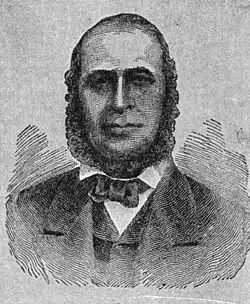Charles Bennett Ray

Charles Bennett Ray (December 25, 1807 – August 15, 1886) was a prominent African-American abolitionist, the owner and editor of the weekly newspaper The Colored American, and a notable journalist and clergyman.[1]
Early life and education
Born a free man in Falmouth, Massachusetts, Ray was the son of mail carrier Joseph Aspinwall Ray and his wife Annis Harrington.[1] He attended Wesleyan Seminary in Wilbraham, Massachusetts studying theology, and then in 1832 enrolled as the first black student at Wesleyan University in Middletown, Connecticut although his enrollment was revoked less than two months later after white students protested.[2] He moved to New York City in 1832 and opened a boot and shoe store.[3]
Ministry
Ray became a Methodist minister and later a Congregational minister, serving as pastor of two predominately white churches in New York City, Crosby Congregational Church and Bethesda Congregational Church.[4] Ray was a strong supporter of the temperance movement, and was a member of the American Missionary Association, the African Society for Mutual Relief, and co-founded the Society for the Promotion of Education Among Colored Children.[4]
Abolitionism
In the early 1830s Ray became involved in the abolitionist movement, and became a prominent promoter of the Underground Railroad. He was also co-founder and director of the New York Vigilance Committee and a member of the American Anti-Slavery Society, assisting runaway slaves.[5][6] Ray was also active in the Society of the Promotion of Education Among Colored Children.[7]
The Colored American
In 1838 Ray and Phillip A. Bell became co-owners of The Colored American, the fourth weekly periodical published by African Americans, and Ray became the sole owner and editor in 1839.[6] The Colored American promoted “the moral, social and political elevation of the free colored people; and the peaceful emancipation of the slaves.”[4] Ray traveled throughout the north giving speeches condemning African American prejudice, and in 1840 became a supporter of the newly founded Liberty Party, the only publicly pro-Abolitionist political party.[1][3][4]
Family
Ray married twice: first in 1834 to Henrietta Green Regulus, who died two years later in childbirth; and again in 1840 to Charlotte Augusta Burroughs. They had seven children, including the first female African-American attorney, Charlotte E. Ray; her sister Florence Ray, who also became an attorney; as well as poet Henrietta Cordelia Ray, known for her eighty-line ode, Lincoln.[1]
Charles B. Ray died in New York City and is buried in Cypress Hills Cemetery in Brooklyn.[4]
Notes
- ↑ 1.0 1.1 1.2 1.3 "Ray, Charles B.(1807–1886) - Abolitionist, editor, Chronology, Joins anti-slavery movement, Works for the colored american". Retrieved 2008-12-31.
- ↑ Wesleyan University - Beginnings: Charles B. Ray to Victor L. Butterfield. "THE ROUTE TO DIVERSITY". Retrieved 2008-12-31.
- ↑ 3.0 3.1 Work, M. N. (1919). "The Life of Charles B. Ray". The Journal of Negro History (Association for the Study of African-American Life and History, Inc.) 4 (4): 361–371. doi:10.2307/2713446. JSTOR 2713446.
- ↑ 4.0 4.1 4.2 4.3 4.4 Larsen, Julia Henning. "Ray, Charles B. (1807-1886)". Retrieved 2008-12-30.
- ↑ "Henry Highland Garnet and the Weims Family...". The Black Abolitionist Papers. Volume: 1. 1985. Retrieved 2008-12-31.
- ↑ 6.0 6.1 "The Life of Charles B. Ray". The Journal of Negro History (Association for the Study of Negro Life and History, Inc.). 1919. Retrieved 2008-12-31.
- ↑ Ray, H. Cordelia and Florence (1887). Sketch of the Life of Rev. Charles B. Ray. New York: Press of J. J. Little.
References
- Ray, Charles B. (1840). Black Churches in New York City, 1840. Colored American. ISBN 978-0-8223-2449-2. Retrieved 2008-12-31.
|